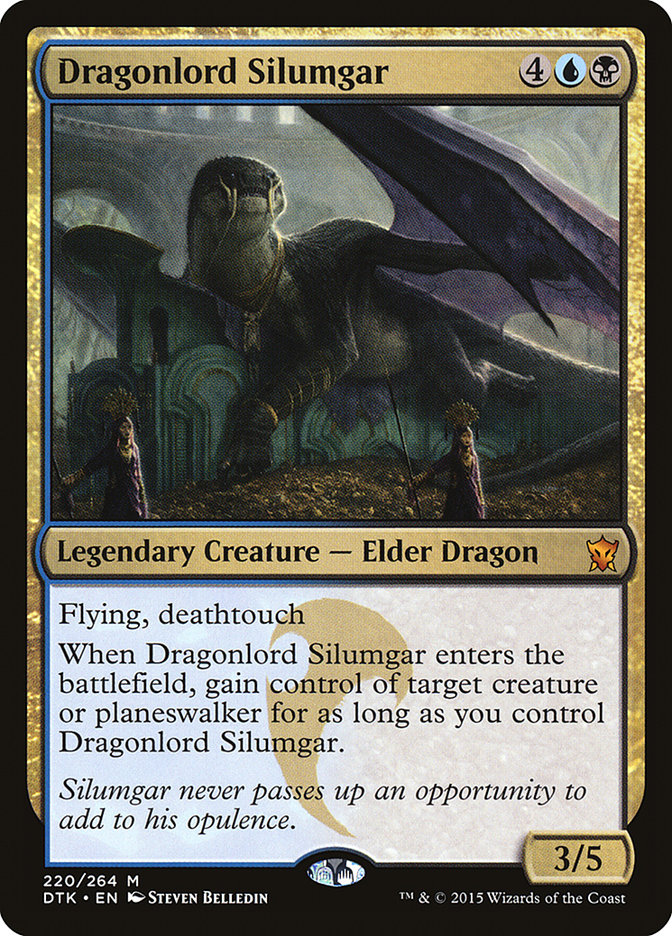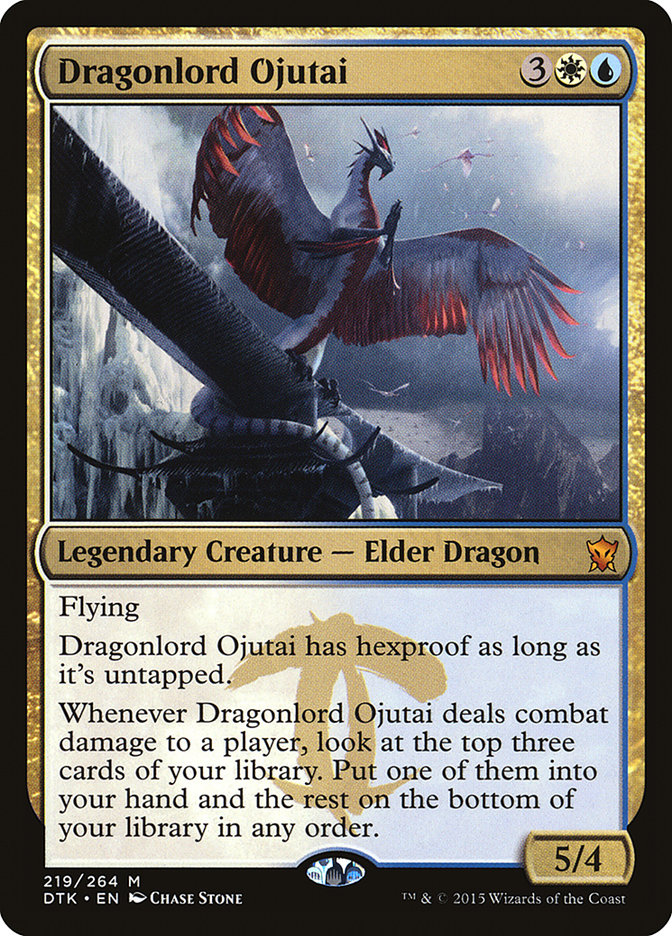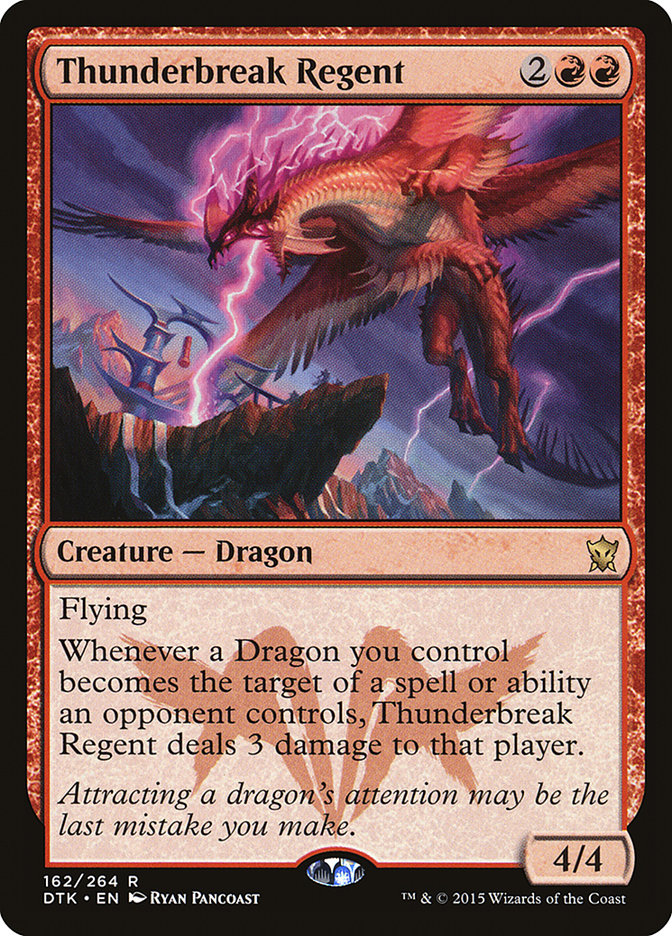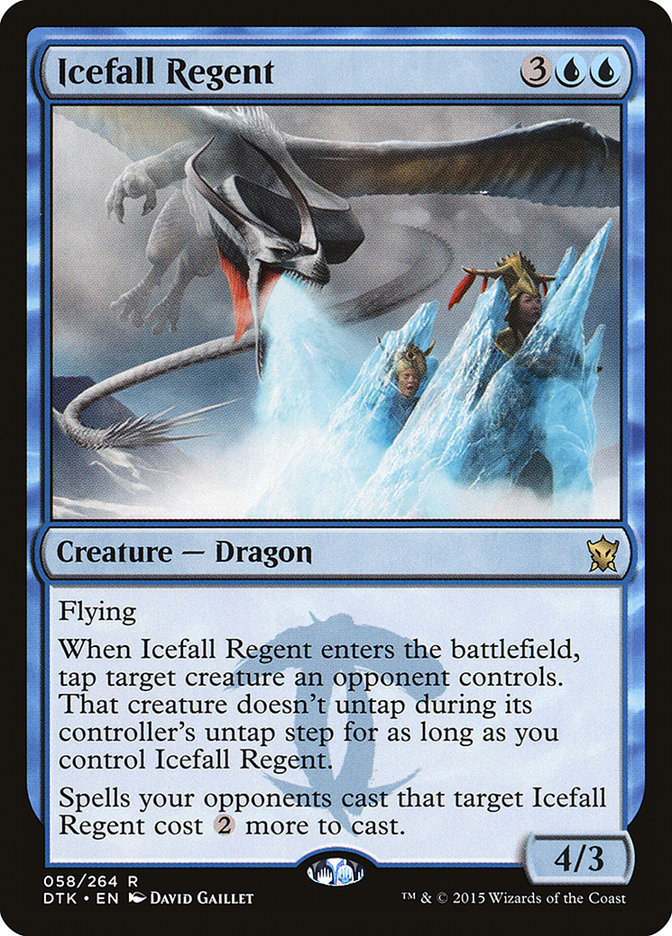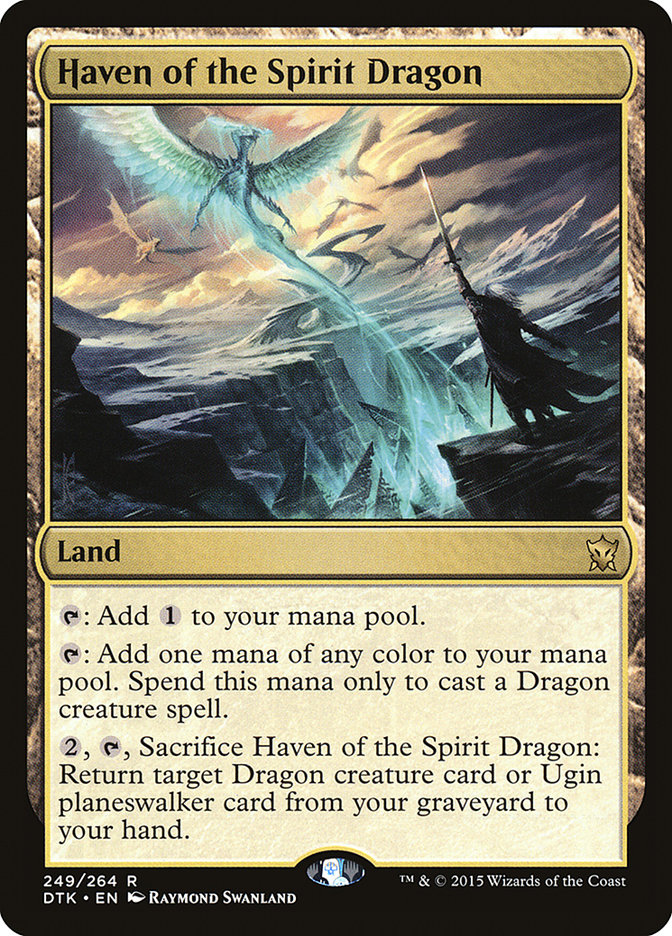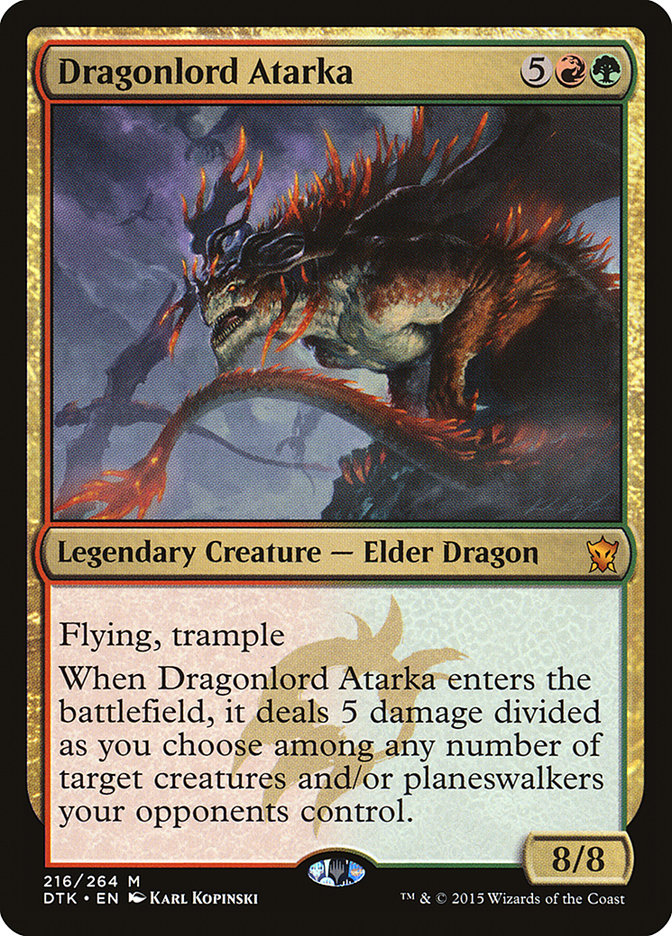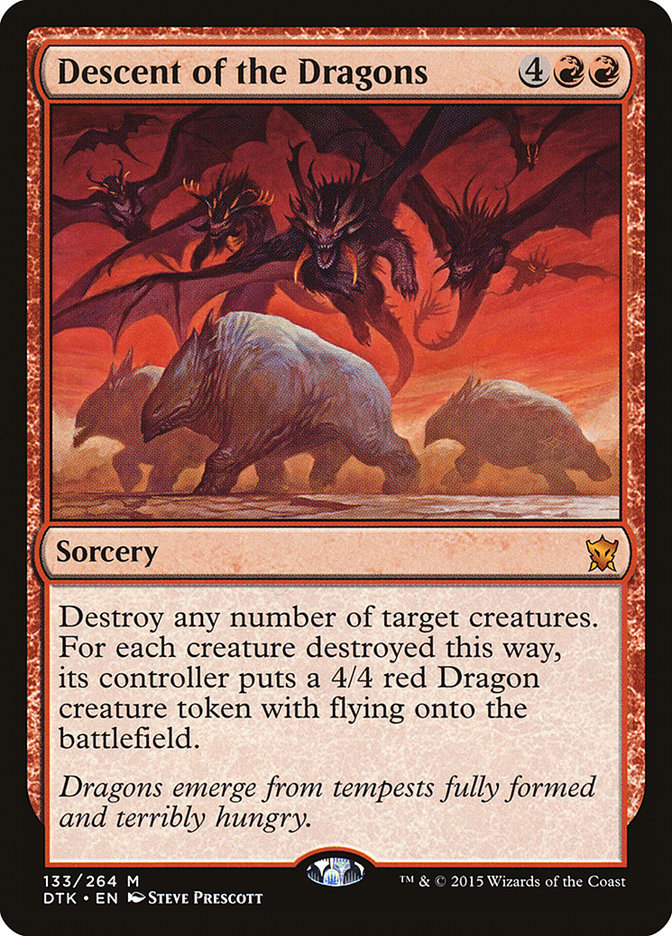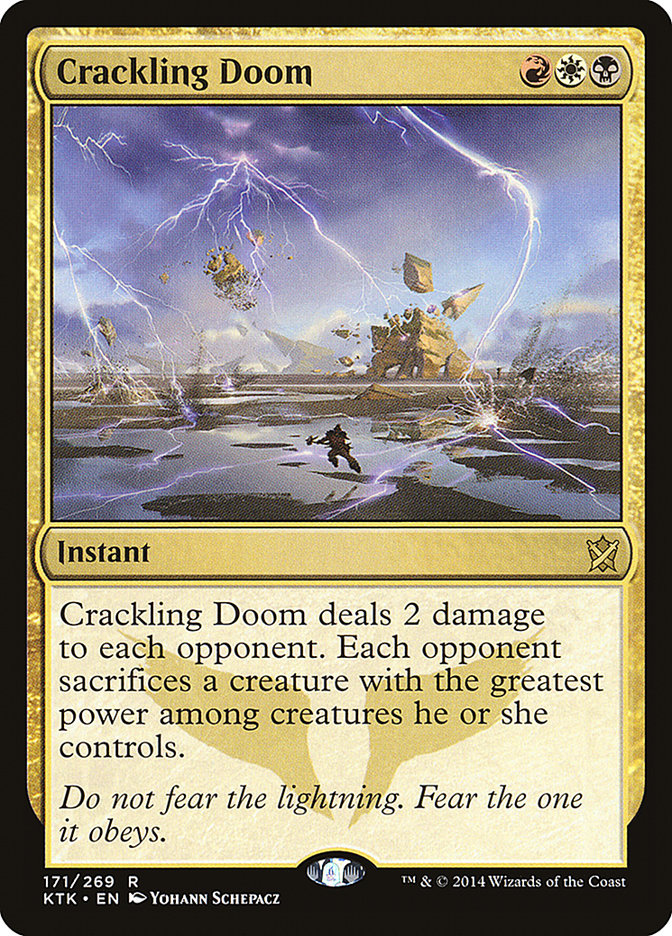If we thought
30
Dragons in the top 8 of the Pro Tour was a lot, what are we supposed to make of
41
Dragons in the top 8 of GP Krakow?
Without question, Dragons of Tarkir has completely revolutionized Standard. I can’t even recall the last time a third set so completely altered a format’s
landscape. Yes, cards like Ultimate Price, Anticipate, Atarka’s Command, and Dromoka’s Command have all been super important, but at its core, this is now
a format about Dragons.
Esper and U/B Control completely dominated the Pro Tour by such a large margin, it isn’t even really fair to describe any other strategy as being a
meaningful rival. A number of players have expressed reservations about playing control moving forward, as the format must obviously warp to beat it,
right?
Well, this weekend, the control stranglehold on the format only increased, with five(!) Esper Dragon decks and a U/B Control deck all making top 8 of GP
Krakow. As if that wasn’t enough Dragons, Sam Pardee took another slot with the Bant Midrange deck (splash Dragonlord Ojutai) that carried Craig Wescoe to
a top 16 finish at Pro Tour Dragons of Tarkir.
All five Esper Dragons decks in the top 8 were within a couple cards of Paulo Vitor Damo Da Rosa’s Pro Tour deck. Fittingly, PV is one of the five to top 8
the Grand Prix with the strategy. I think it’s pretty clear at this point. This wasn’t just the best deck of the Pro Tour, but it is the defining deck of
the format. If you want to compete in Standard, you’ve got to be able to hang with this deck.
Here is the composite list resulting from aggregating the five top 8 lists:
Creatures (5)
Planeswalkers (1)
Lands (27)
Spells (27)

The composite on just raw numbers actually featured a third sideboarded Drown in Sorrow and only one Bile Blight in the sideboard; however, four out of
five of the lists featured four Bile Blights in the 75, and it appeared to be caused by unfortunate rounding. It is not clear that Drown in Sorrow is the
appropriate card to cut for it, however. Other options include the Ultimate Price or the Negate.
Interestingly, PVDDR’s list was identical to the composite, aside from the following deviations:
-He played a Disdainful Stroke maindeck instead of the third Dissolve.
-He sideboarded an Ashiok, Nightmare Weaver instead of the Negate.
If I were to play in a Standard tournament tomorrow, I would play PV’s exact list unless he advocates any changes.
That said, I’m interested in other angles to hit the format from. Last week, I touched on the dedicated morph decks I was
considering for PT Dragons of Tarkir. For instance:
Creatures (28)
- 4 Elvish Mystic
- 4 Rattleclaw Mystic
- 2 Icefeather Aven
- 1 Sagu Mauler
- 4 Stratus Dancer
- 4 Den Protector
- 4 Deathmist Raptor
- 4 Ire Shaman
- 1 Ainok Survivalist
Lands (22)
Spells (10)

The combination of Den Protector and Deathmist Raptor is great for fighting through the removal and counterspells of Esper Dragon decks, and I’m interested
to see if a tuned version of this concept can exploit how much less popular big fast creature decks and devotion are than they used to be.
Another concept I’d like to revisit is one that showed some promise in testing but wasn’t quite there.
It was only during a podcast with Michael Flores last week that I realized the
interaction between Battlefield Thaumaturge and Descent of the Dragons. Is this the missing link?
Dragon Tempest + Descent of the Dragons is already a very powerful combination that deals 21 damage to your opponent if you have just three creatures on
the battlefield. A fourth creature, and we’re up to 32 damage. Each creature becomes a Dragon and each Dragon deals damage each to the total number of
creatures (Dragons) you have, plus four from attacking with haste.
Battlefield Thaumaturge is a very exciting addition to this concept because of how much it reduces the cost of Descent of the Dragons. We’re generally
targeting three or four creatures anyway, so that makes the final part of the combo cost just two or three mana. For instance:
Turn 2: Dragon Tempest
Turn 3: Hordeling Outburst
Turn 4: Battlefield Thaumaturge + Descent of the Dragons (32 damage)
First, here’s a first draft of straight U/R Dragon’s Descent:
Creatures (8)
Lands (24)
Spells (28)
- 2 Magma Jet
- 4 Dragon Fodder
- 2 Goblinslide
- 4 Hordeling Outburst
- 4 Dig Through Time
- 4 Dragon Tempest
- 4 Anticipate
- 4 Descent of the Dragons
Sideboard

I’ve got three major problems with this deck:
- This list is short on creatures. I am not confident that we’re reliably going to have three or more creatures to Descent. What if we don’t draw
Hordeling Outburst? Worse still, what if our opponent casts Bile Blight? - That brings us directly to the second major problem, which is that this deck seems ill-suited to fighting the control-heavy metagame dominating the
real world. Even if we get lucky and face a non-control deck, we’re still potentially looking at problems with Dromoka’s Command. - Card quality. Staying two colors has us stretching for playables, with cards like Dragon Fodder and Goblinslide being pretty dubious inclusions on
that list.
My solution? Adding green. Green gives us plenty of creatures we can actually play that cantrip or produce mana. It also gives us a meaningful anti-control
plan and a big increase in card quality.
Creatures (21)
- 4 Sylvan Caryatid
- 3 Courser of Kruphix
- 4 Satyr Wayfinder
- 4 Battlefield Thaumaturge
- 3 Den Protector
- 3 Deathmist Raptor
Lands (23)
Spells (16)
Sideboard

Now we’re talking! Satyr Wayfinder, Courser of Kruphix, and Den Protector all draw cards, meaning we don’t actually have to invest many cards in the combo.
Sylvan Caryatid is hard to kill and gives us more creatures for our mana. Deathmist Raptor is obviously anti-removal, as well, but it can also be a virtual
cantrip. Whenever we mill it with Satyr Wayfinder or Commune with the Gods, then unmorph a creature, it’s like we’re drawing a card.
When it comes to actually setting up the combo, Dig Through Time is the clear best Dig spell. The addition of Satyr Wayfinder and Commune with the Gods
means we’re going to fill up our graveyard much faster. Commune is a tutor for Dragon Tempest, of course, but it can also help us find more Den Protectors.
Den Protector means even milling Descent of the Dragons can be a way for us to access it.
I’m not at all sure about the mix of Anticipate verus Commune with the Gods. There’s a limit to how much durdling you have time to do, so we can’t max out
on this stuff. Anticipate doesn’t dig as hard, but it does give us better looks for Descent, plus it can help us find land or Dig Through Time. I wouldn’t
be surprised, however, if Commune’s ability to fill our graveyard ends up being so valuable that we just want to max out on it. Besides, having more looks
for Battlefield Thaumaturge is a big deal.
For instance, while we’d love to open:
Turn 2: Sylvan Caryatid
Turn 3: Satyr Wayfinder + Dragon Tempest
Turn 4: Battlefield Thaumaturge + Descent of the Dragons
We’re not always going to draw Sylvan Caryatid (or the combo naturally). Battlefield Thaumaturge generally means we’re comboing at least a turn early, even
if we spent the time to Commune with the Gods.
Turn 2: Satyr Wayfinder
Turn 3: Courser of Kruphix
Turn 4: Commune with the Gods + Dragon Tempest
Turn 5: Battlefield Thaumaturge + Descent of the Dragons
The combo of Dragon Tempest + Descent of the Dragons is stronger than it may appear on the surface, but I’m not sure a deck can survive the current
Standard format without a bit of removal. There are some really devastating creatures that can’t be left unchecked for long.
Another concept I had been working on for the Pro Tour that showed promise in some areas but struggled because of a lack of creature removal was Blue
Devotion. I started here:
Creatures (28)
- 4 Thassa, God of the Sea
- 4 Master of Waves
- 4 Hypnotic Siren
- 4 Frost Walker
- 4 Stratus Dancer
- 4 Gudul Lurker
- 4 Shorecrasher Elemental
Lands (25)
Spells (7)
Sideboard

However, I just kept getting run over by Goblin Rabblemaster. Even sideboarding Encase in Ice and Encrust does nothing to stop the Rabblemaster from
ripping us apart.
In an effort to address this weakness, I tried the following build:
Creatures (25)
- 4 Master of Waves
- 2 Jeskai Sage
- 4 Stratus Dancer
- 4 Shorecrasher Elemental
- 4 Palace Familiar
- 4 Silumgar Sorcerer
- 3 Icefall Regent
Lands (25)
Spells (10)
Sideboard

This build moves away from the pure small, pure beatdown creatures, instead playing more of a tempo-game. The interaction between Palace Familiar/Jeskai
Sage + Silumgar Sorcerer is cool, and Master of Waves is pretty good at demolishing red aggro decks if you aren’t already dead to Goblin Rabblemaster, but
I still find the general power level of the deck to be mediocre, and it’s not like the synergy is off the charts.
For instance, we’re not even trying to support Thassa any more, as it is just too hard to reliably have even a devotion of five. Opponents play too much
removal, and we don’t have double blue two-drops. Additionally, having so many reactive spells really eats into our permanent count. At least Silumgar
Sorcerer is a good source of devotion when you need it, and a counterspell when you need that.
The question I keep facing is why go to all the trouble? Why are we even trying to push the devotion theme when Thassa and Nykthos aren’t even part of the
equation any more. It’s not like Master of Waves is some unbeatable card in the format (even if it is great).
An interesting note for red players that might have to face Master of Waves: remember, you can use Wild Slash to kill the Master. While protection from red
means you can’t target it, Wild Slash’s ferocious ability means damage can’t be prevented to anyone all turn. If you attack with a few red creatures and
the Master blocks one (which it will), you can Wild Slash your opponent (or one of the Wave tokens), and as long as you had a Goblin Rabblemaster or
Thunderbreak Regent, the Master’s protection from red won’t save it. Foundry Street Denizen, Monastery Swiftspear, and Lightning Berserker are all other
possible ways to get up to four-power for the ferocious ability.
Of course, this cuts both ways. If you’re piloting the above list, you better be careful about casting Wild Slash in the middle of combat when you have an
Icefall Regent in play. The last thing you want to do is accidentally kill your Master of Waves blocking a red creature.
In thinking more about moving away from Blue Devotion, I wondered what it might look like to just play up the Bident + fliers angle.
Creatures (24)
- 4 Stormbreath Dragon
- 1 Flamewake Phoenix
- 4 Stratus Dancer
- 4 Thunderbreak Regent
- 4 Palace Familiar
- 4 Silumgar Sorcerer
- 3 Icefall Regent
Lands (26)
Spells (10)

This list embraces the Dragon tribe, significantly upgrading its burn and permission. The challenge, of course, is that this list is playing eleven
creatures that cost four or more. We’re starting to talk about a much slower gameplan. I also found the use of the red Dragons in a base blue deck to be a
bit schizophrenic. This list isn’t fast enough to reliably be the aggressor (unlike builds with green acceleration), and the red Dragons make very poor
defenders.
Another possible direction to go with Blue Devotion is a black splash instead of a red one. After all, we’re really just splashing for removal anyway.
Maybe black removal is better suited to the Dragon-heavy format we see today? Besides, there are a few U/B gold cards we might want to use.
Creatures (18)
Planeswalkers (3)
Lands (26)
Spells (13)

I like Ashiok with Master of Waves, and once we’ve got this many creatures worth killing, Dragonlord Silumgar starts getting pretty appealing. The thing
is, once we start down this path, there is more and more pressure to play a heavier removal package and more card draw. Next thing you know, we’re just
playing U/B Dragons.
Near the end of our testing in Brussels, I was experimenting with dedicated five-color Dragon decks. While I never found a support package I was happy
with, I was liking the following core:
4 Crucible of the Spirit Dragon
The combination of Sylvan Caryatid, Courser of Kruphix, and Shaman of Forgotten Ways on top of eight (or nearly eight) Dragon-lands made it very easy to
splash all five colors of Dragons into a two-color deck. What I was finding was that “Dragons” was sort of its own color, and that you could splash
whatever “third color” you wanted into your green/Dragons deck.
What that splash should be, I’m not sure, but here are some possible mana bases for each possible splash:
White
4 Crucible of the Spirit Dragon
4 Forest
1 Plains
White is an easy splash since you get a fetchland, and Silumgar is the only bomb Dragonlord that requires a double splash. To help support him, we’ve opted
for Sandsteppe Citadel, instead of Blossoming Sands, since it is effectively a “tri-land” producing green, white, or “Dragon” for the only hard to cast
Dragon in our deck.
Blue
4 Crucible of the Spirit Dragon
4 Forest
While Yavimaya Coast isn’t as appealing as Windswept Heath, blue is the perfect color to splash for making our mana easy since it means that all of the
bomb Dragonlords are single splashes.
If we want enough blue to support Silumgar’s Scorn, we are going to need to significantly tweak the deck, perhaps cutting the four Forests and a Crucible
of the Spirit Dragon for three more Opulent Palaces and two Islands. Even with such a manabase, however, we are going to be very strained trying to cast
Silumgar’s Scorn early. I think you can be base blue or base green, but it’s probably not realistic to try to be both.
Black
4 Crucible of the Spirit Dragon
4 Forest
A black splash means Dragonlord Ojutai is the bottleneck. To help alleviate troubles casting our five-drop, we can use Sandsteppe Citadel as a tri-land,
like above. The Urborg, Tomb of Yawgmoth is an extra nod to black for Crux of Fate, which I imagine to be one of the main draws to black, along with
Thoughtseize and Foul-Tongue Invocation. A black build has extra reason to consider Satyr Wayfinder alongside or in place of Sylvan Caryatid because of
Crux of Fate and a few possible graveyard cards (like Whip of Erebos), although any of the color combinations might want it.
Red
4 Crucible of the Spirit Dragon
4 Forest
1 Mountain
It’s possible that we’d want a second Mountain, particularly if we added Thunderbreak Regent and/or Stormbreath Dragon, but remember, the Havens and
Crucibles are going to make those Dragons very easy to cast anyway, so it’s probably not necessary unless we want a double red card like Anger of the Gods
or Chandra, Pyromaster. To me, the main draw of red is Xenagos, the Reveler, however.
There is one more card I wanted to discuss a little this week:
Crackling Doom is sick right now. It’s basically the best ever against everyone. It kills Dragonlord Ojutai and Silumgar, the Drifting Death, of course,
but it’s also the perfect answer to Thunderbreak Regent (no targeting), Stormbreath Dragon (protection from white?), and actually undoes some of the damage
done by Siege Rhino.
Where is the best home for Crackling Doom? Here’s a stab at it:
Creatures (12)
Lands (24)
Spells (24)

Maybe it’s just crazy to not build to Chained to the Rocks, but I am suspicious of that card right now. It’s terra-bad against Esper Dragons and even the
aggro decks are loaded with stuff like Dromoka’s Command. Yes, this list is far from Dromoka’s Command-proof, but I am just not sure that Chained to the
Rocks even lines up that well with the strategies people actually play.
Of course, we could also try Crackling Doom in a fast aggro deck (probably base red, though maybe base white), a black midrange card advantage Abzan-y kind
of deck, or possibly even a real Abzan deck that splashes red for Crackling Doom (or perhaps a Mardu deck that splashes green for Siege Rhino). There are a
lot of possibilities, but I think one way or the other, there has to be a Crackling Doom deck. The card is just too good against the popular strategies.
This format already bears little resemblance to last month.
I’ve got a feeling the evolution is just getting started…

